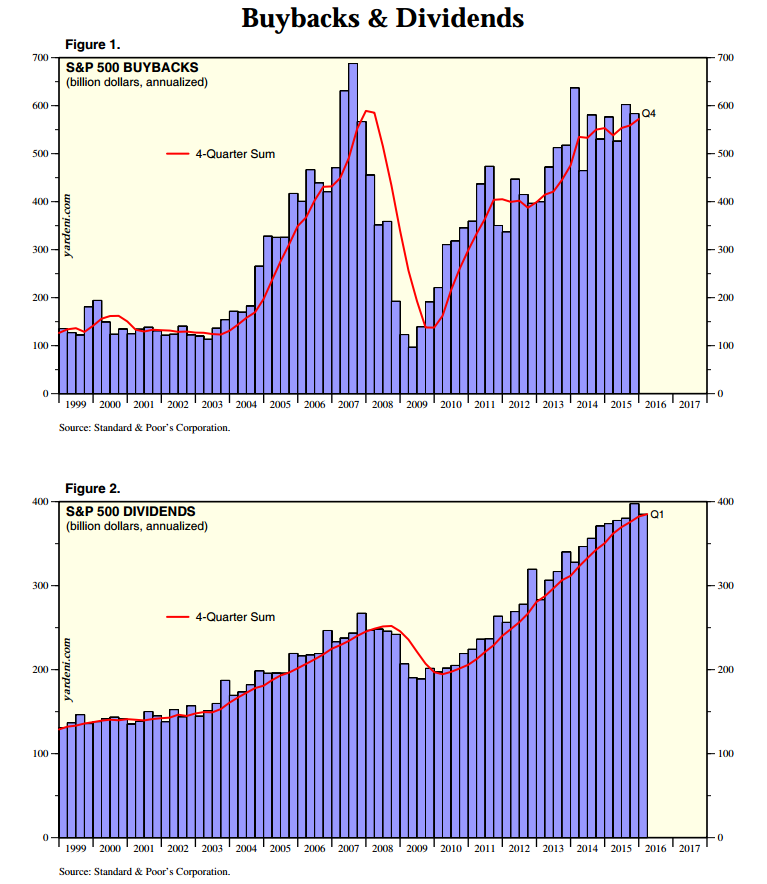The biggest source of fresh cash in American equities isn’t speculators or exchange-traded funds -- it’s companies buying their own stock, by a 6-to-1 margin.
--Bloomberg News, March 2015
There's been a lot of chatter about stock buybacks the past few years. Some people believe share repurchases are propping up the market; others think this is a myth, or a non-story. There is the claim that buybacks are identical to dividends, but this turns out to be less true in practice than in theory. Some analysts claim dividend stocks are the new bonds, because dividends represent positive returns and tend to be more reliable than buybacks. Meanwhile, asset managers have been wondering why companies have been buying back shares rather than investing in their underlying businesses.
Academics have been looking at the buybacks-versus-dividends debate for a long time: In 1986, Michael Jensen of Harvard Business School published a seminal paper on the advantages of paying cash to shareholders.
Whether you prefer buybacks or dividends likely depends upon your time horizon. Buybacks seem to have a stronger short-term impact, while longer-term advantages fall to dividends. Let's look at some of the plusses and minuses of each:
No. 1. Buybacks tend to be expensive and ill-timed. It's not just that companies buy when share prices are high, but that the purchases tend to be pro-cyclical. What this means is that most buybacks take place when companies are flush with cash. This tends to occur during the stronger portions of the earnings cycle -- not when stocks are cheap, but after they have enjoyed a big run up.
No. 2. Buybacks are used to offset the increase in the number of shares outstanding when executives and employees exercise stock options. This is especially true in technology companies, where employee-stock options are a standard part of compensation. As much as many people think buybacks are propping up the market, often their true purpose is offsetting dilution.
No. 3. Buybacks are more often financed with debt, which makes the company’s balance sheet less resilient; as the Wall Street Journal's Justin Lahart observed, many U.S. companies went on a borrowing binge, with (nonfinance) companies adding $1.4 trillion in debt during the past three years. Meanwhile, they bought back $1.3 trillion in stock.
No. 4. One of the more intriguing aspects of buybacks is their role in putting a floor under earnings, because after a repurchase net income is divided by a smaller number of shares outstanding in per-share profit calculations. This was discussed in a paper last year titled "The Real Effects of Share Repurchases," which found that share repurchases occur more often in companies that are likely to miss earnings forecasts than those that don't.
No. 5. In theory, dividends and share repurchases should be economically identical; in practice, however, there are lots of human errors that weigh heavily on buybacks. My colleague Ben Carlson observes that “it’s generally a bad idea to sell more of your assets after they have fallen a great deal and buy more or your assets after they have risen a great deal.” Yet that describes what happens so often in share sales and stock buybacks.
No. 6. Companies have no obligation to complete announced share buybacks, nor do they say when they have halted buybacks; they just stop buying shares. If asked, the standard response is that market conditions are not favorable.
The following chart illustrates how much buybacks fell during the financial crisis compared with reductions in dividends:

As for dividends:
No. 1. Dividends are an actual real return of cash to investors.
No. 2. Companies will not lightly reduce or suspend a dividend. As Michael Masboussin of Credit Suisse wrote in 2014:
Dividends provide a strong signal about management’s commitment to distribute cash to shareholders and its confidence in the future earnings of the business. For this reason, companies are very deliberate about the decision to initiate a dividend. Executives perceive buybacks as being more flexible than dividends and as a lever that can increase earnings per share under the right conditions.
No. 3. Dividends are not typically financed with debt; most of the time they are paid for out of cash flow.
No. 4. The returns of companies that issue dividends have been beating those of companies that buy back shares during the past year, according to Liz Ann Sonders, chief investment strategist of Charles Schwab & Co.No. 5. It is true that dividends can have tax consequences, while buybacks don't.
The bottom line is that buybacks tend to be expensive, poorly timed, pro-cyclical, subject to cancellation without notice, not guaranteed and often serve to offset compensation for company insiders. Dividends represent a real return of cash to shareholders, are carefully considered, counter-cyclical and durable.
A company can't destroy value by returning cash in the form of a dividend. But it can surely waste money on a buyback. In order for a share buyback to return 100 cents on the dollar, a lot of things have to go just right.
On balance, that’s why I prefer dividends to buybacks.
Barry Ritholtz started the Big Picture blog in 2003 and is the founder of Ritholtz Wealth Management, an asset management and financial planning firm.